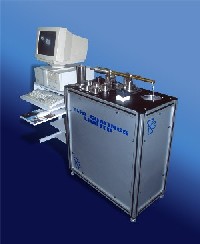The pin on disc tester- A quick and easy method of kinetic friction and sliding wear measurement
The pin on disc tester measures the friction and sliding wear properties of dry or lubricated surfaces of a variety of bulk materials and [relevant-to-adsense type=”start”]thin film coatings[relevant-to-adsense type=”stop”]. The pin on disc tester consists of a rotating disc of the material to be tested against a stationary sphere, usually made of cemented carbide, referred to as the pin. Although the pin surface can also be wear and friction tested. The normal load, rotational speed, and the wear track diameter are all be set by the user prior to the pin on disc test.
Pin on disc tester – Computer controlled
Most pin on disc testers are computer controlled and store the measured friction versus time or distance plots for future reference. When the friction is monitored during the pin on disc test the friction starts at it’s highest level but after a certain amount of time (or running in) the friction drops to a steady state level. After the pin on disc test has completed the amount of coating remaining in the wear track is measured using the ball crater technique or Calo test that creates a crater in the wear track left after the pin on disc test and simple software with the Calo tester gives the coating wear rate. The coefficient of friction is calculated by dividing the friction by the applied load.

A ball crater after a pin on disc test on a low friction coating
Graphit-iC coating, load 80 N, pin on disc test time 30 minutes.
The pin on disc tester is used extensively to measure the friction and wear rate of low friction coatings such as diamond like carbon prior to coating actual components such as automotive valve trains. As the valve train in an engine is responsible for approximately 10% of the engine’s total energy losses due to friction at high engine speeds ( this increases at low engine speeds). Low friction coatings therefore increase the efficiency and lifetime of these components significantly. As the use of low friction coatings becomes more widespread so does the requirement for wear and friction measurement and hence the use of the pin on disc tester.

